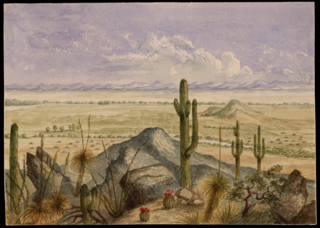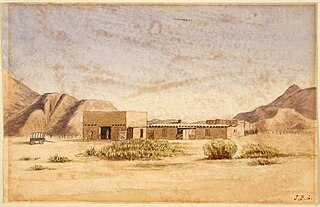
Pinal County is a county in the central part of the U.S. state of Arizona. According to the 2020 census, the population of the county was 425,264, making it Arizona's third-most populous county. The county seat is Florence. The county was established in 1875.

Gila Bend, founded in 1872, is a town in Maricopa County, Arizona, United States. The town is named for an approximately 90-degree bend in the Gila River, which is near the community's current location. As of the 2020 census, the population of the town was 1,892.

Sacaton is a census-designated place (CDP) in Pinal County, Arizona, United States. The population was 3,254 at the 2020 census. It is the capital of the Gila River Indian Community.

The Gila River Indian Community (GRIC) is an Indian reservation in the U.S. state of Arizona, lying adjacent to the south side of the cities of Chandler and Phoenix, within the Phoenix Metropolitan Area in Pinal and Maricopa counties. The Gila River Indian Community was established in 1859, and the Gila River Indian Community was formally established by Congress in 1939. The community is home for members of both the Akimel O’odham (Pima) and the Pee-Posh (Maricopa) tribes.

The Akimel O'odham, also called the Pima, are an Indigenous people of the Americas living in the United States in central and southern Arizona and northwestern Mexico in the states of Sonora and Chihuahua. The majority population of the two current bands of the Akimel O'odham in the United States is based in two reservations: the Keli Akimel Oʼodham on the Gila River Indian Community (GRIC) and the On'k Akimel O'odham on the Salt River Pima-Maricopa Indian Community (SRPMIC).

The Maricopa or Piipaash are a Native American tribe, who live in the Salt River Pima-Maricopa Indian Community and Gila River Indian Community along with the Pima, a tribe with whom the Maricopa have long held a positive relationship. The Maricopa at the Salt River Pima-Maricopa Indian Community consist mostly of Xalychidom Piipaash members and are concentrated in Lehi. The Maricopa at the Gila River Indian Community are concentrated in Maricopa Colony. The Maricopa are a River Yuman group, formerly living along the banks of the Colorado River.
Fort Barrett was a temporary earthwork built by the United States Army's California Column in 1862 during the American Civil War. It was located in the Pima Villages two miles from the Gila River nearby Casa Blanca, New Mexico Territory and was built around the mill of settler Ammi M. White to protect it and provide a safe location to gather food and forage from the Pima people for the advance on Tucson. The fort was named after Lieutenant James Barrett who was killed in the Battle of Picacho Peak. Following the capture of Tucson in May the construction of the post ceased, and was abandoned, except as a post for vedettes and express riders.

Casa Blanca is a census-designated place (CDP) in Pinal County, Arizona, United States, located in the Gila River Indian Community. The population was 1,388 at the 2010 census.

Pima Villages, sometimes mistakenly called the Pimos Villages in the 19th century, were the Akimel O’odham (Pima) and Pee-Posh (Maricopa) villages in what is now the Gila River Indian Community in Pinal County, Arizona. First, recorded by Spanish explorers in the late 17th century as living on the south side of the Gila River, they were included in the Viceroyalty of New Spain, then in Provincias of Sonora, Ostimuri y Sinaloa or New Navarre to 1823. Then from 1824 to 1830, they were part of the Estado de Occidente of Mexico and from September 1830 they were part of the state of Sonora. These were the Pima villages encountered by American fur trappers, traders, soldiers and travelers along the middle Gila River from 1830s into the later 19th century. The Mexican Cession following the Mexican American War left them part of Mexico. The 1853 Gadsden Purchase made their lands part of the United States, Territory of New Mexico. During the American Civil War, they became part of the Territory of Arizona.

Socatoon Station was a stagecoach station of the Butterfield Overland Mail between 1858 and 1861. It was located four miles (6.4 km) east of Sacaton at a Maricopa village from which it took its name. This station was located 22 miles (35 km) east of Maricopa Wells Station, 11 miles (18 km) east of Casa Blanca Station and 13 miles (21 km) north of Oneida Station.
Arenal, "sandy place" in Spanish, also known as Aranca No.1 in the 1857 census, was one of the 19th century Pima Villages, located along the Gila River, in what is now the Gila River Indian Community in Pinal County, Arizona.
Hormiguero, Spanish for "anthill",, one of the 19th century Pima Villages, was located along the Gila River, in what is now the Gila River Indian Community in Pinal County, Arizona.
El Llano, Spanish for "the plain or open space" or Buen Llano, "good plain", one of the 19th century Pima Villages, was located along the south side of the Gila River, between Sweetwater and Sacaton, in what is now the Gila River Indian Community in Pinal County, Arizona.
Hueso Parado, Spanish for “Standing Bone” or El Juez Tarado Spanish for "The Judge Tarado", was the largest village of the Maricopa people in the 19th century, in what is now the Gila River Indian Community in Pinal County, Arizona.
Agua Raiz, Spanish for "Water root" as named in the 1860 Census, it was one of the 19th century Pima Villages, located along the Gila River, near the modern site of Sacate Village, Arizona in what is now the Gila River Indian Community in Pinal County, Arizona.

San Simon River is an ephemeral river, or stream running through the San Simon Valley in Graham and Cochise County, Arizona and Hidalgo County, New Mexico. Its mouth is at its confluence with the Gila River at Safford in Graham County. Its source is located at 31°51′21″N109°01′27″W.
Tres Alamos Wash, an ephemeral stream tributary to the San Pedro River, in Cochise County, Arizona. It runs southwesterly to meet the San Pedro River, across the river from the former settlement of Tres Alamos, Arizona. Tres Alamos Wash passes east and northeastward between the Little Dragoon Mountains and Johnny Lyon Hills to where it arises in a valley east of those heights and west of Allen Flat and the Steele Hills. It has its source at 32°07′45″N110°02′59″W.

Sacate Village is a census-designated place in Pinal County, in the U.S. state of Arizona. The population was 169 at the 2010 census.

Sacate is a populated place in the Middle Gila River Valley area, within Pinal County, Arizona, United States. Located 8 mi (13 km) north of Maricopa on the south side of the Gila River near Pima Butte, Sacate was an Pima village, a railroad station of the Southern Pacific Railroad, and a Catholic mission. It had originally been called Sacaton Station but the name was shortened to its current version in 1904.
Cachanillo was one of the 19th century Pima Villages, located along the Gila River, in what is now the Gila River Indian Community in Pinal County, Arizona.















